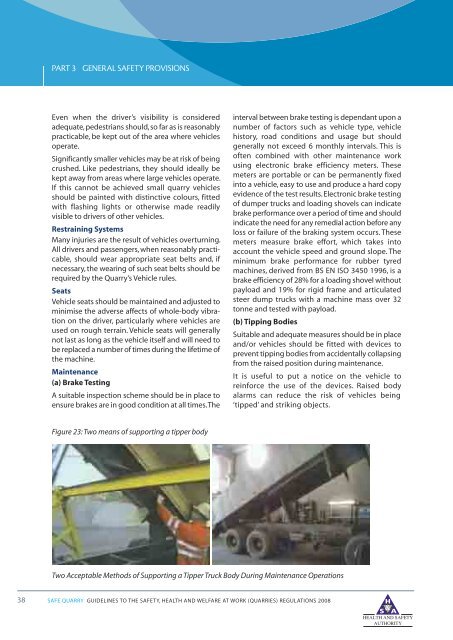Safe Quarry - Health and Safety Authority
Safe Quarry - Health and Safety Authority
Safe Quarry - Health and Safety Authority
Create successful ePaper yourself
Turn your PDF publications into a flip-book with our unique Google optimized e-Paper software.
PART 3<br />
GENERAL SAFETY PROVISIONS<br />
Even when the driver’s visibility is considered<br />
adequate, pedestrians should,so far as is reasonably<br />
practicable, be kept out of the area where vehicles<br />
operate.<br />
Significantly smaller vehicles may be at risk of being<br />
crushed. Like pedestrians, they should ideally be<br />
kept away from areas where large vehicles operate.<br />
If this cannot be achieved small quarry vehicles<br />
should be painted with distinctive colours, fitted<br />
with flashing lights or otherwise made readily<br />
visible to drivers of other vehicles.<br />
Restraining Systems<br />
Many injuries are the result of vehicles overturning.<br />
All drivers <strong>and</strong> passengers, when reasonably practicable,<br />
should wear appropriate seat belts <strong>and</strong>, if<br />
necessary, the wearing of such seat belts should be<br />
required by the <strong>Quarry</strong>’s Vehicle rules.<br />
Seats<br />
Vehicle seats should be maintained <strong>and</strong> adjusted to<br />
minimise the adverse affects of whole-body vibration<br />
on the driver, particularly where vehicles are<br />
used on rough terrain. Vehicle seats will generally<br />
not last as long as the vehicle itself <strong>and</strong> will need to<br />
be replaced a number of times during the lifetime of<br />
the machine.<br />
Maintenance<br />
(a) Brake Testing<br />
A suitable inspection scheme should be in place to<br />
ensure brakes are in good condition at all times.The<br />
interval between brake testing is dependant upon a<br />
number of factors such as vehicle type, vehicle<br />
history, road conditions <strong>and</strong> usage but should<br />
generally not exceed 6 monthly intervals. This is<br />
often combined with other maintenance work<br />
using electronic brake efficiency meters. These<br />
meters are portable or can be permanently fixed<br />
into a vehicle, easy to use <strong>and</strong> produce a hard copy<br />
evidence of the test results. Electronic brake testing<br />
of dumper trucks <strong>and</strong> loading shovels can indicate<br />
brake performance over a period of time <strong>and</strong> should<br />
indicate the need for any remedial action before any<br />
loss or failure of the braking system occurs. These<br />
meters measure brake effort, which takes into<br />
account the vehicle speed <strong>and</strong> ground slope. The<br />
minimum brake performance for rubber tyred<br />
machines, derived from BS EN ISO 3450 1996, is a<br />
brake efficiency of 28% for a loading shovel without<br />
payload <strong>and</strong> 19% for rigid frame <strong>and</strong> articulated<br />
steer dump trucks with a machine mass over 32<br />
tonne <strong>and</strong> tested with payload.<br />
(b) Tipping Bodies<br />
Suitable <strong>and</strong> adequate measures should be in place<br />
<strong>and</strong>/or vehicles should be fitted with devices to<br />
prevent tipping bodies from accidentally collapsing<br />
from the raised position during maintenance.<br />
It is useful to put a notice on the vehicle to<br />
reinforce the use of the devices. Raised body<br />
alarms can reduce the risk of vehicles being<br />
‘tipped’ <strong>and</strong> striking objects.<br />
Figure 23: Two means of supporting a tipper body<br />
Two Acceptable Methods of Supporting a Tipper Truck Body During Maintenance Operations<br />
38<br />
SAFE QUARRY GUIDELINES TO THE SAFETY, HEALTH AND WELFARE AT WORK (QUARRIES) REGULATIONS 2008
















